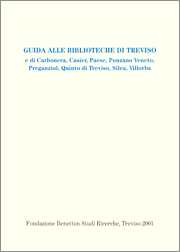
Guida alle biblioteche di Treviso
e di Carbonera, Casier, Paese, Ponzano Veneto, Preganziol, Quinto di Treviso, Silea, Villorba
[Guide to the libraries of Treviso, Carbonera, Casier, Paese, Ponzano Veneto, Preganziol, Quinto di Treviso, Silea, Villorba]
Fondazione Benetton Studi Ricerche
Treviso 2001
XVII-150 pages
2 maps
We conceived the compilation and publication of this Guide as our duty to Treviso. The underlying work took over a year and the result embodies the combined efforts of a number of individuals and institutions, in particular the Veneto branch of the Italian Library Association. The Guide describes 102 libraries altogether, 80 of them in Treviso itself (with half inside the walls and half outside), and a further 22 in the eight surrounding municipalities.
The overall pattern features a small group of “major” libraries that own most of the collections of old and rare books and a varied archipelago of smaller libraries run by schools, municipal administrations, associations and parish churches. The survey shows an astonishing range of libraries of different dimensions, specializations, organizational structures and statutory purposes. In all we estimate there must be around one million three hundred thousand books and about ten thousand periodicals. There is a significant weighting towards local history and the cultural heritage. Facilities tend to be concentrated (both quantitatively and qualitatively) within the city walls and to be correspondingly thinly spread over substantial swathes of territory “outside”.
In an area like Treviso, where we have begun to use the term “città diffusa” or “urban sprawl”, the whole area ought to be covered by a basic library service with guaranteed minimum characteristics and opening times. The survey points to base libraries as centres of cultural life, places for reading of all sorts, including newspapers, spaces for normal and necessary meeting and social interchange. Another theme that emerges is that of open schools, with libraries accessible to the community as a whole, with cultural activities and permanent education, with suitable spaces and opening times and responding not only to the study needs of pupils but also to the cultural enrichment requirements of their families and of all the inhabitants of the area. At the same time the main libraries should be encouraged and supported so that they can perform to the full their equally important function as places of study and research.
Much remains to be done in terms of designing and implementing consistent action to safeguard, enhance and promote the cultural heritage constituted by our libraries. Ideas under consideration include digitalisation, unification and publication on the web of all the various catalogues; protection of private libraries, which are often in danger of decay and being broken up; the creation of new public libraries in an urban area with ambitions to become a “university city”. In the meantime, we believe it is useful to know and publicize the libraries there are.
Contents
Presentazione, VII
Introduzione, IX
Come consultare la guida, XII
Treviso, 1
Carbonera, 87
Casier, 91
Paese, 95
Ponzano Veneto, 97
Preganziol, 101
Quinto di Treviso, 107
Silea, 109
Villorba, 113
Indice per denominazione, 122
Indice per località, 125
Indice per tipologia, 129
Indice per ente di appartenenza, 132
Indice per argomenti, 136
Indice per denominazione di fondi e lasciti, 144
Indice analitico delle denominazioni delle schede, 146
